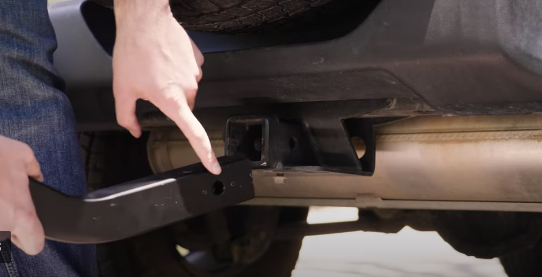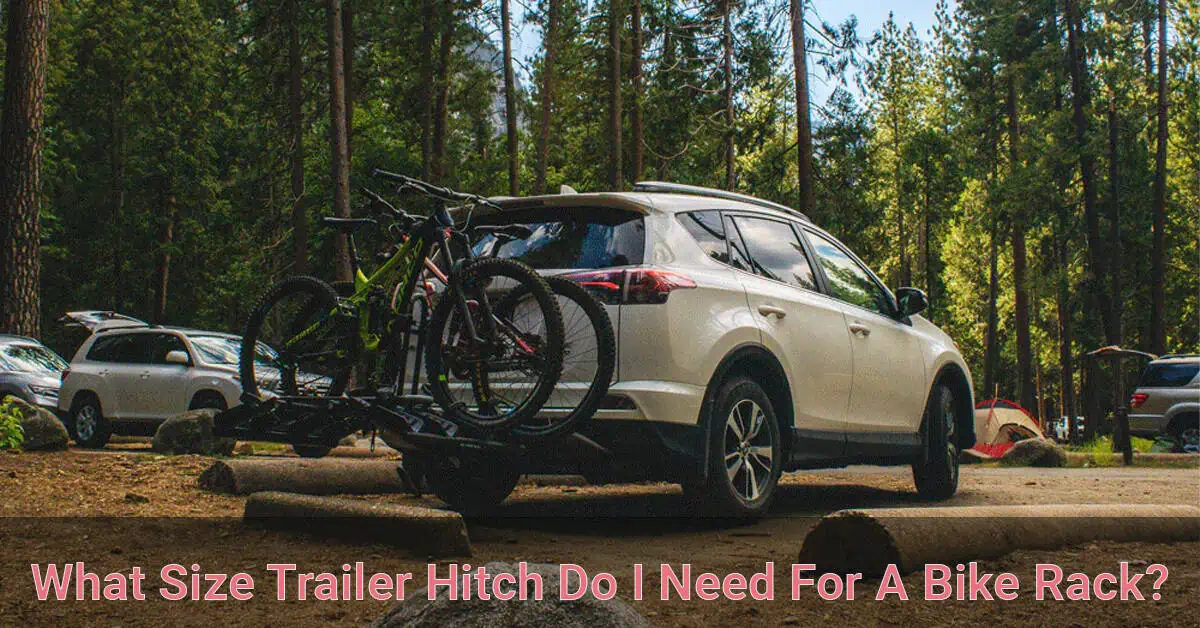As cycling enthusiasts, we all dream of effortlessly transporting our bikes to scenic trails, group rides, or weekend getaways. Excellent choice! But before you snag that shiny new rack, a crucial question arises: what size trailer hitch do I need? Fear not, fellow cyclist, for this guide will equip you with the knowledge to confidently choose the perfect hitch size for your ride.
Check Size Here: Bike Size Calculator Tool
Detailed Answer: What Size Trailer Hitch Do I Need for a Bike Rack?
Understanding Trailer Hitch Sizes
- Class I and Class II Hitches:
- These hitches are suitable for lightweight bike racks and can typically carry two to three bikes.
- If you plan to transport a small group of cyclists, these hitches should suffice.
- However, if you’re eyeing a family biking adventure or need to accommodate more bikes, read on.
- Class III and Higher Hitches:
- When carrying four or more bikes, or if you want the flexibility to swing the rack to the side, you’ll need a Class III or higher hitch.
- These hitches offer greater strength and stability, making them ideal for heavier loads.
Measuring Your Bike Rack’s Shank
The shank of your bike rack plays a crucial role in determining the required hitch size. Here’s how to measure it:
- 2-Inch Shank:
- If your bike rack’s shank measures 2 x 2 inches, you’ll need a Class III or higher 2-inch receiver.
- These hitches are common and can handle substantial weight.
- 1-1/4-Inch Shank:
- If your bike rack’s shank measures 1-1/4 x 1-1/4 inches, you’ll need to consider whether it fits a Class I or Class II hitch.
- Class I and Class II hitches are suitable for lighter loads, so ensure your bike rack’s weight falls within their capacity.
Choosing the Right Trailer Hitch Size
Now, to the million-dollar🙂 question: Which trailer Hitch size is right for you? Consider these factors:
- Vehicle type: As mentioned above, smaller vehicles typically require the 1 1/4 inch size, while larger ones benefit from the 2-inch option.
- Number of bikes: Carrying 1-2 bikes? A 1 1/4-inch hitch might suffice. Are you planning for 3+ bikes or heavier models? Opt for the 2-inch for better stability and safety.
- Futureproofing: If you envision carrying more bikes or heavier loads in the future, choosing the 2-inch hitch provides more flexibility.
Beyond Size: The Hitch Class Matters:
While size is crucial, don’t forget about hitch class. This indicates the towing capacity and overall strength of the hitch. Match your rack’s weight requirements with the appropriate class (I, II, III, IV, or V). Consult your vehicle’s manual.
How To Install A Hitch Bike Rack
- Determine Hitch Rack Compatibility:
- Before anything else, ensure that your vehicle has a hitch receiver. Most trucks and SUVs come with one, but if yours doesn’t, consider having it installed.
- Check the class of your hitch (Class I, II, III, etc.) to match it with the appropriate bike rack.
- Select the Right Hitch Rack:
- Choose a bike rack that fits your needs. Consider the number of bikes you’ll be transporting and any additional features you require (e.g., swing-away design, tilt function).
- Read the Instructions Manual:
- Each bike rack model has specific installation instructions. Familiarize yourself with them before starting.
- Attach the Rack to the Hitch Receiver:
- Slide the bike rack’s shank into the hitch receiver.
- Secure it using the hitch pin provided. Make sure it’s snug and properly locked.
- Adjust the Bike Rack:
- Some racks allow you to adjust the angle or height. Set it according to your preference.
- Ensure that the rack is level and parallel to the ground.
- Load Your Bikes onto the Hitch Rack:
- Lift your bikes onto the rack one by one.
- Use the bike cradles or straps to secure each bike in place. Double-check that they’re stable.
- Double-Check Security and Clearance:
- Wiggle the bike rack to ensure it’s firmly attached.
- Verify that there’s enough clearance between the bikes, the rack, and your vehicle.
Do You Need A Hitch For Bike Rack?
To use a hitch-mounted bike rack, you do need a trailer hitch on your vehicle. Unlike roof and trunk racks, which don’t require a trailer hitch, a hitch-mount bike rack relies on this essential component. Here are some key points to consider:
- Hitch Requirement:
- Hitch-mounted bike racks attach directly to a trailer hitch receiver.
- You’ll need to ensure that your vehicle has a hitch receiver installed.
- Fortunately, hitches can be added to various vehicles, from small hatchbacks to minivans to oversized SUVs.
- Hitch Sizes:
- Hitch receivers come in different sizes: 1-1/4 inches and 2 inches.
- The 2-inch hitch is stronger and can handle more weight. It’s commonly found on large SUVs and trucks.
- Passenger cars typically have a 1-1/4-inch hitch, which is still suitable for carrying bicycles.
- Best Option:
- For bike racks, I recommend using a trailer hitch paired with a hitch-mounted rack.
- Benefits of using a trailer hitch:
- Easy installation.
- Minimal risk of damage to the car or bike.
- The foldable design allows you to close your garage door without removing the rack.
- Keep in mind that you’ll need a 2-inch receiver hitch for optimal compatibility2.
Remember, a well-installed hitch ensures a secure ride for your bikes.
How Much Does It Cost To Install A Hitch For The Bike Rack?
The cost of installing a hitch receiver for a bike rack can vary based on several factors. Here’s what you need to consider:
- Type of Vehicle:

- Hitch size and class: Larger hitches and higher classes naturally cost more due to the materials and complexity involved.
- Vehicle type: Installation on sedans and hatchbacks might be simpler than on SUVs or trucks, impacting the price.
- Expect to pay anywhere from $50 to $200 for installation.
- Existing Holes in the Bumper:

- If your vehicle already has pre-existing holes in the bumper for hitch installation, the cost might be lower.
- However, if new holes need to be drilled into the car’s metal, the price could be higher.
- Is It Worth It?:
- While the cost may seem significant, especially if your bike isn’t expensive, consider the convenience.
- A hitch-mounted bike rack is easy to use and secure, making the additional cost worthwhile for serious cyclists.
- Safety and Quality:
- Proper installation is crucial. Incorrect drilling or poor-quality hardware can damage your car.
- Consult with a professional and choose the right hardware for your installation.
What Size Hitch Is Needed for a Bike Rack?
The hitch size you need depends on your bike rack’s shank.
2-inch hitches are common and can handle substantial weight. If your bike rack has a 2-inch shank, go for a Class III or higher hitch.
For a 1-1/4-inch shank, consider a Class I or Class II hitch.
Choose based on the number of bikes you’ll transport and the hitch’s capacity.
Do All Bike Racks Fit All Hitches?
No, not all bike racks fit all hitches.
Ensure your bike rack’s shank matches the hitch receiver size (1-1/4 inches or 2 inches).
Some racks are compatible with both sizes but always check the specifications.
Is a 1-1/4-Inch or 2-Inch Hitch Better?
2-inch hitches are generally better due to their strength and versatility.
They handle heavier loads and accommodate larger bike racks.
If you have a smaller car, a 1-1/4-inch hitch may suffice.
Is It Worth Getting a Hitch for a Bike Rack?
Yes, if you’re a serious cyclist or frequently transport bikes.
A hitch-mounted bike rack offers convenience, stability, and easy loading.
Consider the cost of installation and the benefits it brings to your biking adventures.
Final Thoughts
Choosing the right trailer hitch size for your bike rack requires careful consideration. By understanding the available sizes, your vehicle’s capabilities, and your future needs, you can make an informed decision that ensures safe and enjoyable bike transportation adventures.
